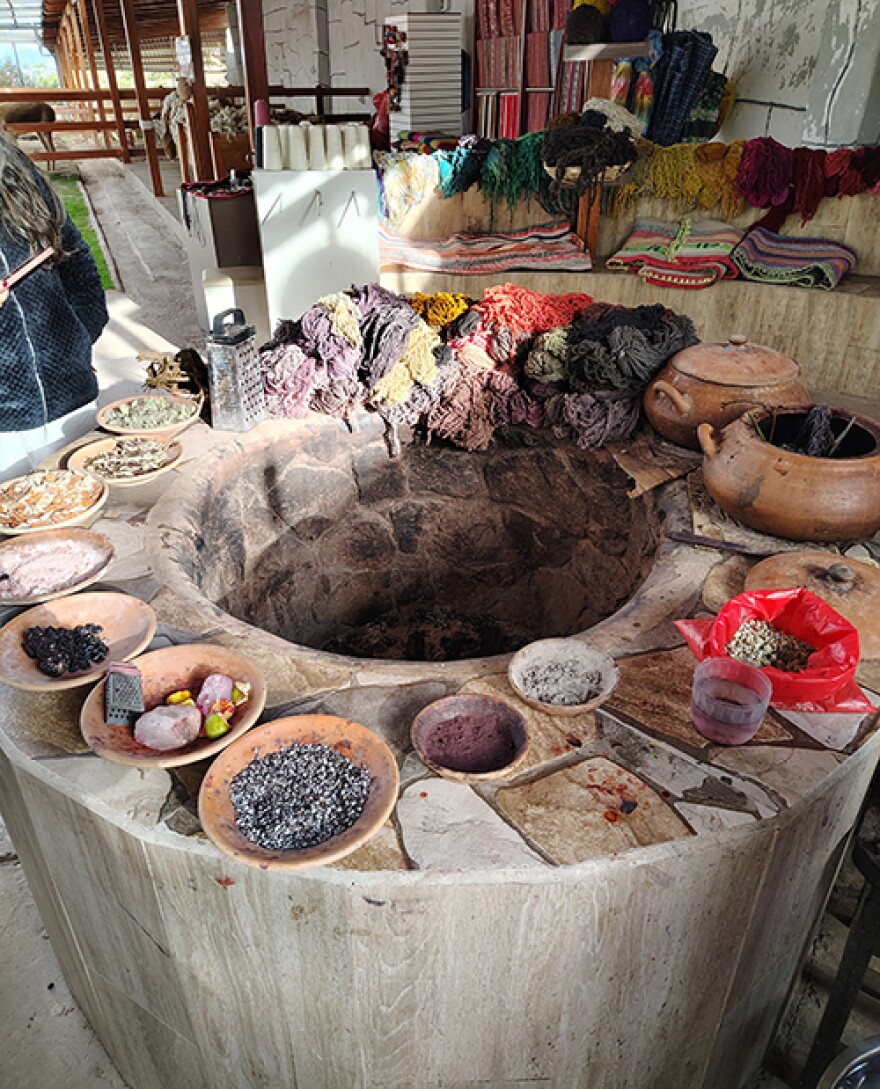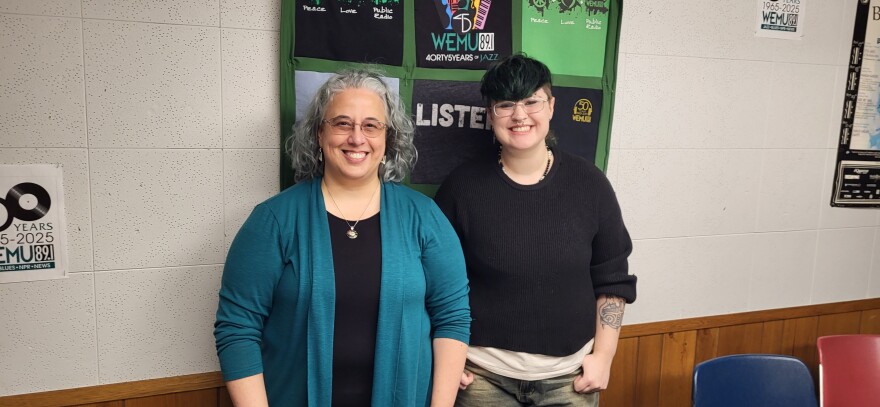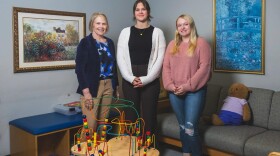Resources:
Lee Van Roth's Feature Article: EMU professor and students present Peruvian mummy research at international congress
Eastern Michigan University Department of Chemistry
Eastern Michigan University scholars unearth new insights with mummy research in Peru
World Congress on Mummy Studies
Transcription:
Lee Van Roth: You're listening to 89.1 WEMU. I'm Lee Van Roth, and this is On the Ground Ypsi. Over the summer, Eastern Michigan University made its mark on the global stage when chemistry professor Ruth Ann Armitage and two undergrad students traveled to Cusco, Peru to present their research on 2,000-year-old textiles from Peruvian mummies at the World Congress on Mummy Studies. Their work uses advanced analytical techniques to uncover the origins, dyes, and environmental stories hidden within these ancient fibers, bringing together chemistry, archaeology, and the humanities together in some surprising ways. With me today to talk about that research is Ruth Ann herself to go over the experience of presenting on an international stage and the kinds of hands-on opportunities that she has created for her students. Hi, Ruth Ann! Thanks so much for being here today!
Dr. Ruth Ann Armitage: Hi! Thanks for having me!

Lee Van Roth: So, let's start at the...well, at least the beginning for you. The beginning goes a couple thousand years back, it sounds like.
Dr. Ruth Ann Armitage: Sure. Yeah.
Lee Van Roth: How did you and your students first garner this interest in this particular set of artifacts and things? Why mummies, I guess, is a better way to phrase that.

Dr. Ruth Ann Armitage: Sure, sure! So, back around the pandemic, a former mentor of mine reached out to me that a project that she had been doing back in the late 80s and 90s sort of had ended back at that time, and she still had a lot of the samples. And she asked if I would take them for safekeeping in case anything might happen to her. And I inherited this box of samples that I really didn't know much about. So, I reached out to our collaborator, Ann Peters, who's an expert in Paracas period textiles, and she was very excited that we had this incredible cache of material. And we developed some projects to work on, which then required some student help. And it turns out that these samples are from funerary bundles in the Paracas Peninsula of southern Peru. And understanding how they were made and what they're made out of really helps us to understand who those people were.
Lee Van Roth: There are some pretty sophisticated tools and techniques that have gone into this research: things like mass spectrometry, chromatography, spectroscopy? Is that it?
Dr. Ruth Ann Armitage: Yeah!
Lee Van Roth: Oh, excellent! And I'm wondering for folks like me and other folks who maybe don't have this background in chemistry, how do these techniques kind of help to uncover those stories and give you a better look at this time so long ago?

Dr. Ruth Ann Armitage: Sure! So, you can kind of think about this as a little bit of forensic science, but we're studying things that are much, much older--obviously, 2,000 years old. And so, what we're looking at is in the very atoms of the fibers, we have a composition that can tell us sort of where the plants were growing, if we're talking about cotton, what kind of food the llamas and alpacas were eating. There's also the molecules that tell us what plants were being used to make the dyes to give us these beautiful, brilliant colors that have persisted for so long. And by putting all of that together with the archaeology, then we can start to see the people's technology, but also why they were doing these kinds of things.
Lee Van Roth: And then, working with your students on this project as well, what is the process like, as the instructor and as the professor, going into and explaining what this analysis looks like and really what it means at the end of the day?
Dr. Ruth Ann Armitage: So, yeah, a lot of our samples are really just sort of a little bit of yarn in a plastic bag that was collected back in the 1980s. And these samples represent a textile that was wrapped around a person that was placed there by a person. So, you kind of have to have a bit of imagination and kind of step back from "Okay, this is just a little piece of yarn. What can this tell me?" and have them kind of think about who were these people and how did we get this thing and think about its process of how it is sitting in front of you on the table at EMU? And what can we do with that to start to pull apart that kind of information? And so, because these are students with a good background in chemistry, they come at this with, "Well, I understand chemistry, but how does that connect those two things?" And so, you can use this little tiny piece of yarn to start to make those connections between things. And I think that's both important and something that gets the students really excited because they're kind of solving a mystery.

Lee Van Roth: And then, this really exciting opportunity to present in Peru at this Congress. This is the first time that EMU has represented at this particular event.
Dr. Ruth Ann Armitage: To my knowledge. Yeah, yeah.
Lee Van Roth: What was that like in and of itself? I mean, I'm sure just going into that space with this information to share. What was going through your head, and how are you working with the students at that point?
Dr. Ruth Ann Armitage: So, our collaborator was actually organizing a session on funerary textiles. And I said, "Hey, could we be part of this?" And she said, "Absolutely! Let's get you in the program." And then I said, "Well, what about bringing students? Because that would be really exciting!" And she's like, "Oh my gosh! We have to make it happen." So, with support from the Honors College and the Chemistry Department and so many places on campus, apologies for forgetting some, possibly, that the students were literally able to go to the meeting, present their work as a poster, and one of the students had never even traveled internationally before. So, this is an incredible opportunity to go to where these textiles originated from and do some hands-on. We actually did a dyeing workshop up in the little town of Chinchero outside of Cusco. And so, they've really got to see how you make the dyes and make these textiles.

Lee Van Roth: This is an opportunity that you, I mean, at least I would assume, is something that this is an opportunity for a graduate student. This is something that would be afforded as someone who is extremely established in one of these fields that's associated with this work. And you mentioned all of the collaboration on campus from entities on EMU's campus to really make this possible. What was that approach like in putting the experience together for these two undergrad students specifically? How do you ensure that there isn't a culture shock both from the international travel and also being in this space of professionals. I'm sure, that's very intimidating.
Dr. Ruth Ann Armitage: So, the chemistry department, in particular, has this incredibly strong background in undergraduate research. So, we encourage undergraduates to get involved in research very early because chemistry means a lot more when you're actually doing it. I think we all have had a class where we see things and we're like, "What do we do with this?" Well, when you go to the lab, you get to see how it works. And so, we encourage undergrads to get involved. And we only have a master's program, so we don't have highly advanced graduate students. But students have attended conferences in the past, but they were mostly chemists. And so, this was a very different sort of experience where they weren't talking to other chemists. They were talking to archaeologists, but also pathologists and people with lots of experience in medicine. And so, we were all just sort of exchanging ideas and information.
Lee Van Roth: This is WEMU's On the Ground Ypsi. I'm talking with EMU Chemistry Professor Ruth Ann Armitage. Ruth Ann, your student, Avi Dragun, talked about how presenting at this Congress pushed her to rethink her work and the work that she's doing in her in her undergrad program. And I'm wondering, from the perspective of the professor, what are some of those really big integral moments of growth that you hope students experience, either in the lab on campus or in opportunities like this?
Dr. Ruth Ann Armitage: So, I think it really comes down to seeing how chemistry is useful in what they want to study. So, Avi traveled to Italy with their family, and it's like, "Wow, I really wish I could combine chemistry and archeology" and then found out, "Hey, there's actually somebody who does that at EMU!" So, Avi's been working with me since they were 16 because they were in the ECA program.
Lee Van Roth: Wow!

Dr. Ruth Ann Armitage: So technically, they were pre-EMU when they even went to Peru. So, getting to that point, when they see something and are so excited, we brought some new samples back from another collection, and when I had some little preliminary results and I sent a text saying, "Hey, do you want to check this out?" And I got back, "I'll be back! I'll be there in 20 minutes!" So, when somebody's that excited to come to the lab and just see what we can get today, that's pretty exciting.
Lee Van Roth: And following this experience, are there potentially more opportunities down the line, even just on campus, combining the chemistry department with work going on in, maybe even just in other sciences or in some of the other more humanities-driven things. Do you see those opportunities kind of coming up as a result of this or inspired by this?
Dr. Ruth Ann Armitage: I think probably inspired by. I know there's lots of interest in the College of Arts and Sciences to have the arts and the sciences work a little more closely together.
Lee Van Roth: Makes sense.
Dr. Ruth Ann Armitage: And so, I'm hoping that there will be great opportunities for that in the future. We certainly have more materials than I even really know what to do with at this point in time. So, if there are students who are interested in doing this, they can always reach out to the chem department, and we can talk about some of the things that they could do.
Lee Van Roth: Well, Ruth Ann, thank you so much for joining me today and sharing about this exciting project and really how exciting it is as for the students to be able to have these opportunities!
Dr. Ruth Ann Armitage: Yeah, thanks so much for having me!

Lee Van Roth: For more on today's conversation and a link to the full article, visit our website at WEMU dot org. On the Ground Ypsi is brought to you in partnership with Concentrate Media. I'm Lee Van Roth, and this is your community NPR station, 89.1 WEMU-FM Ypsilanti. Celebrating 60 years of broadcasting at Eastern Michigan University!
Non-commercial, fact based reporting is made possible by your financial support. Make your donation to WEMU today to keep your community NPR station thriving.
Like 89.1 WEMU on Facebook and follow us on X (Twitter)
Contact WEMU News at 734.487.3363 or email us at studio@wemu.org







